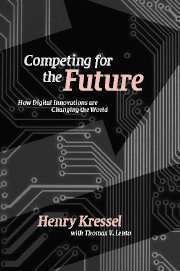Book contents
- Frontmatter
- Contents
- List of figures
- List of tables
- Acknowledgements
- Introduction
- Part I The technology – how electronic devices work – digital systems and software
- Part II Innovators, entrepreneurs, and venture capitalists
- 3 Edison's legacy: Industrial R&D
- 4 R&D goes global
- 5 Financing innovation: Venture capital
- Part III Global reach, global repercussions
- Appendix 1.1 Smaller, faster, more efficient MOSFETs
- Appendix 1.2 Building multi-transistor logic gates
- Appendix 1.3 MOSFETs in memory devices
- Appendix 1.4 CMOS reduces logic gate power dissipation
- Appendix 1.5 Laser diode basics
- Appendix 1.6 Light-emitting diodes (LEDs)
- Appendix 1.7 Photodetectors
- Appendix 1.8 Making fiber optic cables
- Appendix 1.9 Principles of LCD displays
- Appendix 2.1 The demise of analog computers
- Appendix 2.2 IP, TCP, and the Internet
- Appendix 2.3 Building an object-oriented program
- Index
4 - R&D goes global
from Part II - Innovators, entrepreneurs, and venture capitalists
Published online by Cambridge University Press: 07 December 2009
- Frontmatter
- Contents
- List of figures
- List of tables
- Acknowledgements
- Introduction
- Part I The technology – how electronic devices work – digital systems and software
- Part II Innovators, entrepreneurs, and venture capitalists
- 3 Edison's legacy: Industrial R&D
- 4 R&D goes global
- 5 Financing innovation: Venture capital
- Part III Global reach, global repercussions
- Appendix 1.1 Smaller, faster, more efficient MOSFETs
- Appendix 1.2 Building multi-transistor logic gates
- Appendix 1.3 MOSFETs in memory devices
- Appendix 1.4 CMOS reduces logic gate power dissipation
- Appendix 1.5 Laser diode basics
- Appendix 1.6 Light-emitting diodes (LEDs)
- Appendix 1.7 Photodetectors
- Appendix 1.8 Making fiber optic cables
- Appendix 1.9 Principles of LCD displays
- Appendix 2.1 The demise of analog computers
- Appendix 2.2 IP, TCP, and the Internet
- Appendix 2.3 Building an object-oriented program
- Index
Summary
Innovation is an historic and irreversible change in the way of doing things … This covers not only techniques, but also the introduction of new commodities, new forms of organization, and the opening of new markets … Major innovations entail the construction of a new plant and equipment, but not every new plant embodies an innovation.
We must distinguish, says Schumpeter, between innovation possibilities and the practical realization of these possibilities. Prosperity does not arise merely as a result of inventions or discoveries. It waits upon the actual development of innovations which is the driving power of the period of prosperity.
Technology, like life, evolves in stages. The genesis of digital electronics was a handful of simple yet profound innovations, the silicon counterparts of single-celled organisms in primordial seas. Soon successive generations of the technology, each more complex than the last, appeared at unheard-of speed and spread across the face of the earth.
Unlike the progenitor of life, the creative spirit behind the digital electronics revolution is easy to identify. It is the genius of innovation, embodied in the visionary researchers who developed solid-state electronics, ICs, sensors, and software.
Fifty years ago these innovators were concentrated within the pioneering R&D organizations of a few American corporations. They invented the transistor, fiber optics, the microprocessor, and the semiconductor laser. They created new software structures and languages.
In Schumpeter's sense of the term, these were revolutionary innovations, with far-reaching (and largely unforeseen) consequences.
- Type
- Chapter
- Information
- Competing for the FutureHow Digital Innovations are Changing the World, pp. 122 - 174Publisher: Cambridge University PressPrint publication year: 2007



